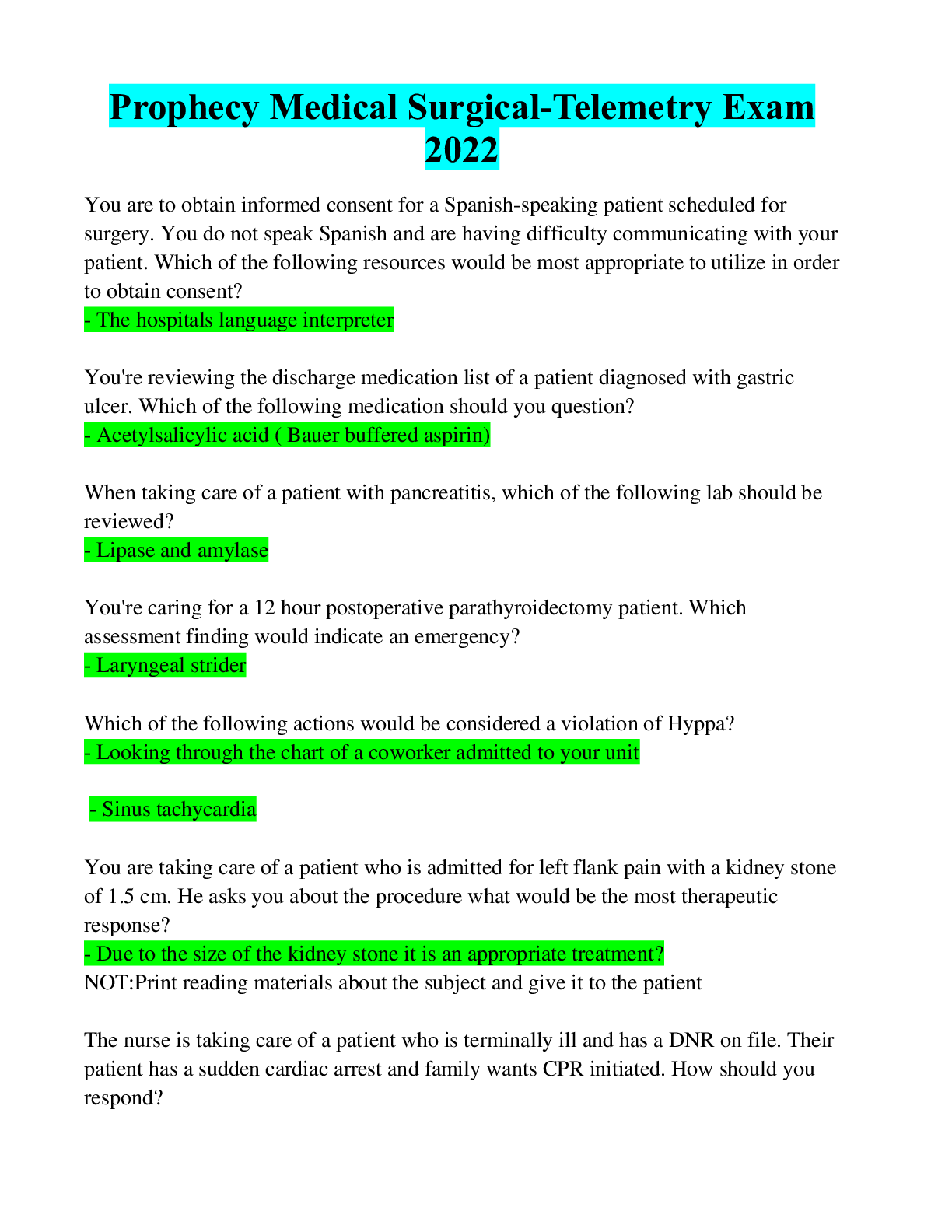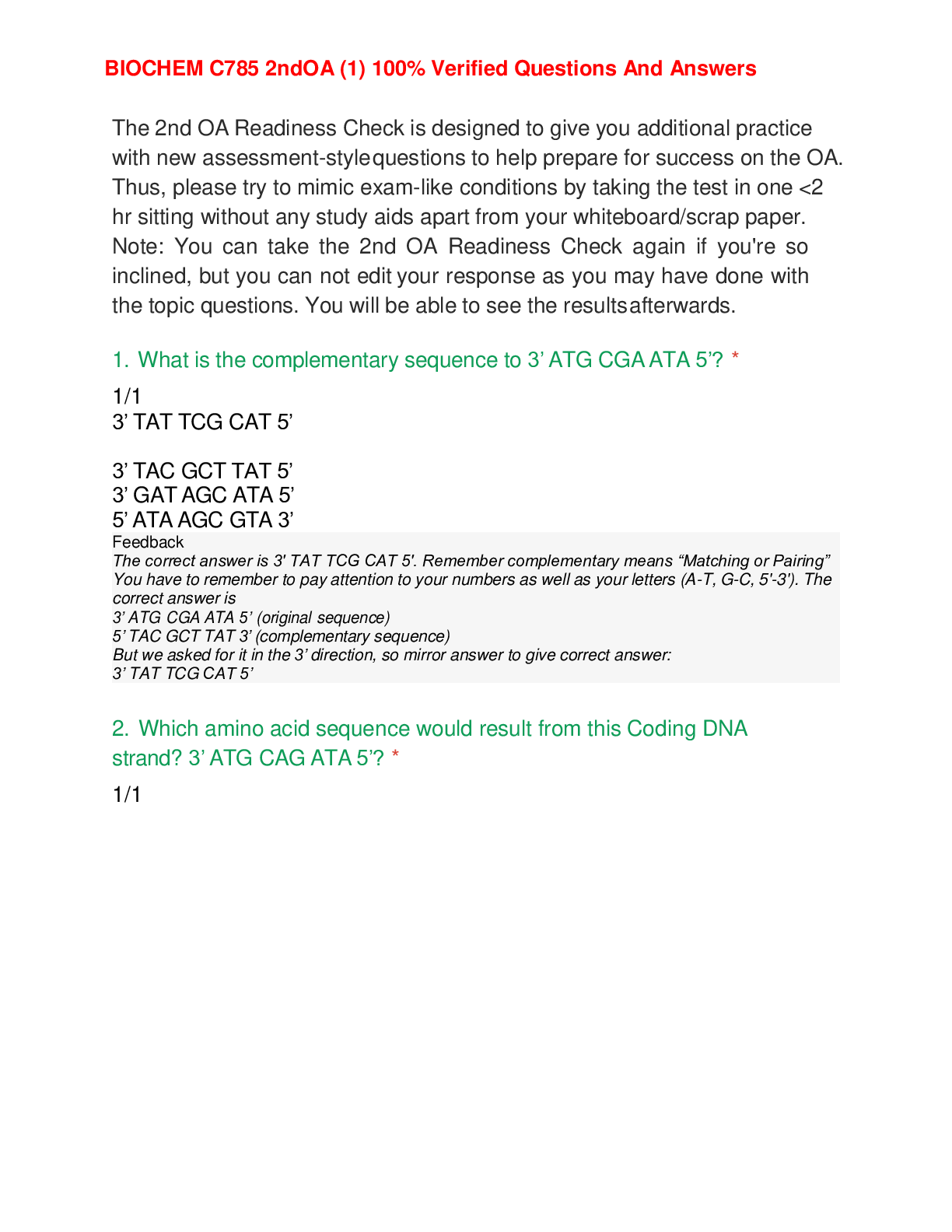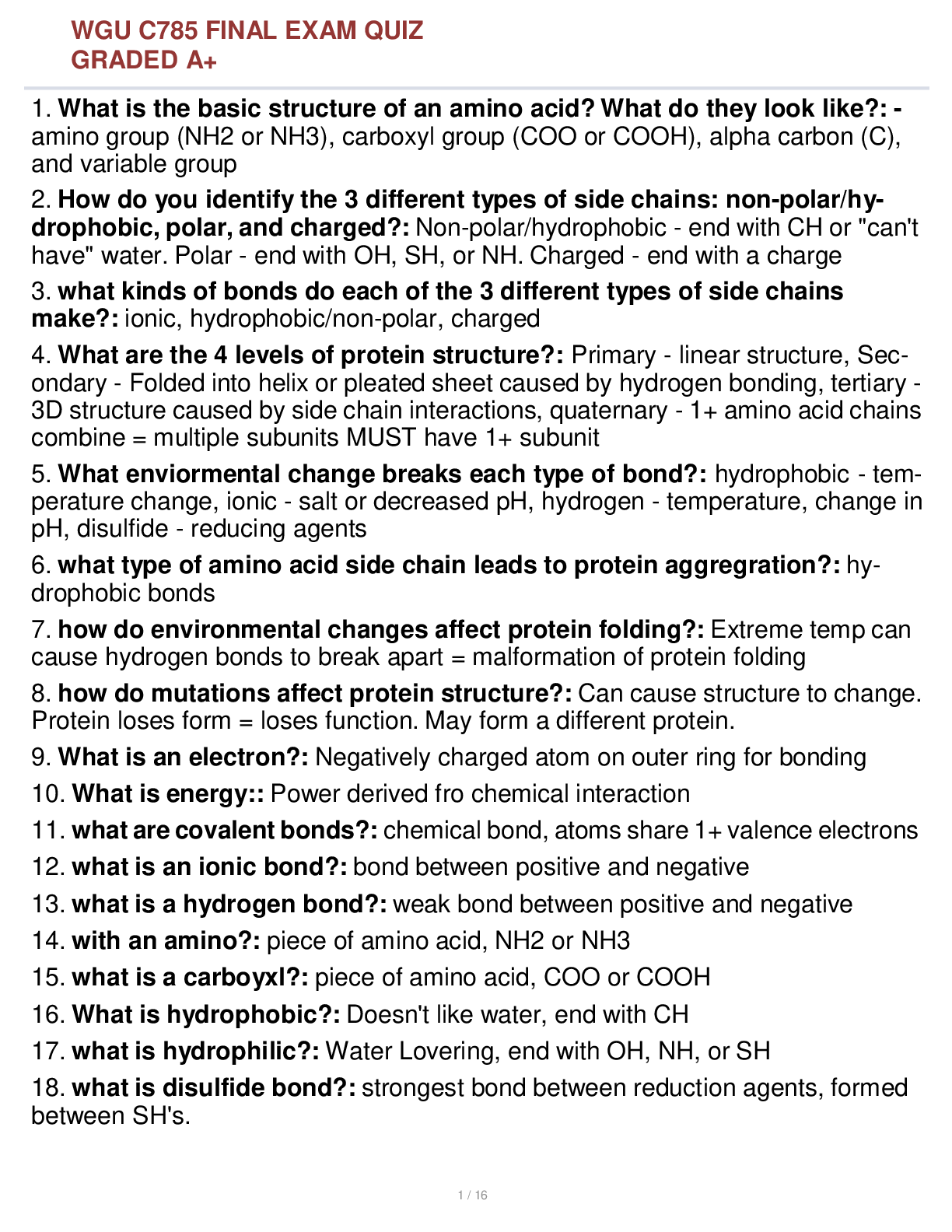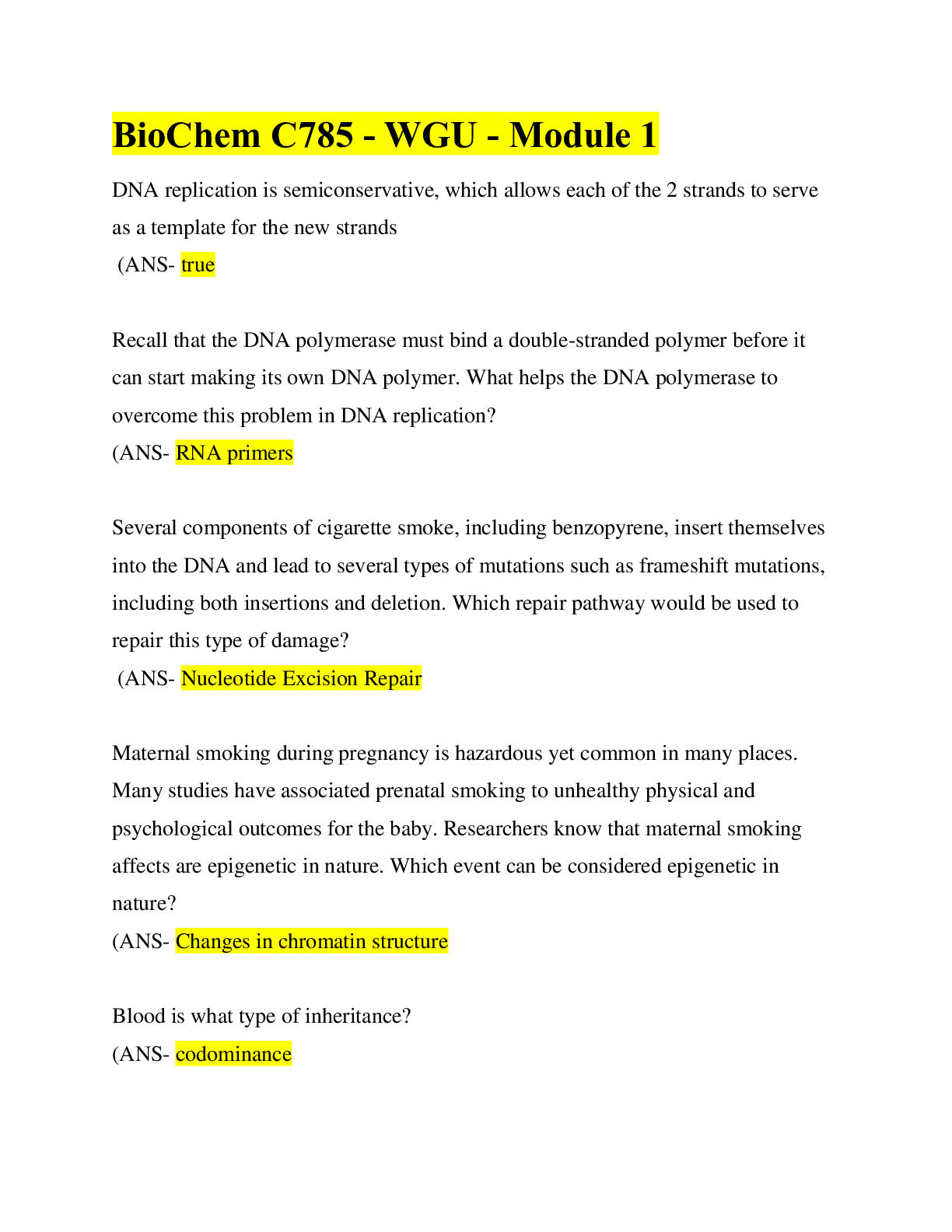Leadership > STUDY GUIDE > Western Governors University - C 155 Final Paper (All)
Western Governors University - C 155 Final Paper
Document Content and Description Below
A. Investigated Disease Process “It’s a horrible, helpless feeling, and it comes on fast. Everything stops, and the wheezing starts as I try to suck in air. I feel my whole body struggle just to... get in oxygen”. Erin S. tells SELF magazine about how it feels when she has an asthma attack (as cited in Miller, 2018, section 7). According to the Centers for Disease Control and Preventions (CDC), there are more than 25 million or 1 in every 13 people currently living with asthma in the United States (Asthma and Allergy Foundation of America, 2018). Asthma is a chronic condition that intermittently inflames and narrows the airways in the lungs. More than half of people with asthma experience at least one asthma attack (a worsening of asthma symptoms) each year. These attacks lead to more than 1.7 million emergency department visits and about 450,000 hospitalizations annually. Moreover, while most deaths due to asthma are preventable, in 2017 3,564 people died from asthma. The disease more prevalent in adult women, African Americans and male children. (National Heart, Lund and Blood Institute, 2018). Swelling in the airways causes symptoms that range from mild to severe such as shortness of breath, coughing, audible wheezing and sometimes feelings of tightness in the chest. Although the exact cause is unknown, we do know that irritants enter the lungs that result in the above symptoms. These irritants can be different for everyone. Such as pollen, pet dander and exercise. Although there is no cure for asthma, it can be treated and managed through proper identification of triggers and selection of medications. I selected asthma as my topic for this paper because it is personal to me as well as a disease that I am interested in learning more about. My spouse has been living with asthma for the past 5 years. We have had our challenges and certainly become more knowledgeable over the years, but I feel that by choosing asthma as my topic of focus I will gain TOPIC IN CAPS 3 a better understanding of the disease process, triggers and treatment and be better capable of taking care of my patients and spouse when their asthma attacks occur. A1. Pathophysiology Asthma is thought of as an inflammatory condition involving the respiratory system. The respiratory system has 3 major components. The airway, the lungs and the muscles of respiration. The airway includes the nose, mouth, pharynx, larynx, trachea, bronchi, and bronchioles and carries air between the lungs and the body’s exterior. The lungs work to pass oxygen into the body and its organs while expelling carbon dioxide out of the body. Lastly, the muscles of respiration are the diaphragm and the internal and external intercostal muscles (Barclay, 2018). The nose is the primary opening for the respiratory system. It warms, moisturizes and filters the air as it enters the body and goes to the lungs. The mouth is the secondary opening for the respiratory system. Contrary to the nose, the mouth does not warm, moisturize or filter the air before entering the lungs. A benefit to mouth breathing is that it allows for a larger volume of air to enter the body at a quicker rate due to the shorter distance to the lungs. The next component of the system is the pharynx. It is most commonly known as the throat and is made up of muscles that extends from the nasal cavity to top of the esophagus and larynx. The pharynx is made up of the nasopharynx, oropharynx and laryngopharynx. The air that enters through the nasal cavity proceeds down through the nasopharynx to the oropharynx and into the lungs. Air that enters through the mouth moves through the laryngopharynx to the lungs. The larynx is your “voice box”. It connects the laryngopharynx to the trachea. The trachea, or TOPIC IN CAPS 4 windpipe, is a tube that is also made of cartilage that connects the larynx to the bronchi and provides a passageway for the air to travel through the neck to the thorax. The trachea also contains cilia, or hair-like projections, that move mucus containing dust and contaminants upward to the pharynx to be swallowed and digested or expelled out of the body. The next area of the respiratory system is the bronchi and bronchioles. The bronchi split the airway into left and right branches that lead into each lung before branching off into smaller secondary bronchi that carry the air into the lobes of the lungs. 2 lobes in the left lung and 3 lobes in the right lung. From there the bronchi split into many smaller bronchioles and alveoli that spread throughout the lungs. The lungs are two spongy organs that fill with air. There is a right and left lung with the left comprising of two lobes and three in the right. The internal and external intercostal muscles located between the ribs, along with the primary respiratory muscle, the diaphragm, work to assist in inhaling and exhaling air from the lungs. Now that I have explained the respiratory system anatomy that is affected by asthma we can move on to the pathophysiology of asthma. The pathophysiology of asthma is complex and involves airway inflammation, intermittent airflow obstruction, and bronchial hyperresponsiveness (Morris, 2019). Airway, or cellular inflammation is the early phase in the pathophysiology of asthma and includes many different cells and factors. It reaches its maximum in the first 30 minutes and resolves within 1 to 3 hours (McCance & Huether, 2019). Most asthmatics have type 2 inflammation. It gets its name from the type 2 T helper cell lymphocyte involved in the response. In addition to the type 2 T helper cell lymphocytes, other inflammatory cells such as mast cells, epithelial cells, macrophages and eosinophils each play a role in the pathophysiology. Some other basic cells that contribute to the chronicity of the disease are endothelial cells and TOPIC IN CAPS 5 fibroblasts. T lymphocytes are the regulators of airway inflammation. They release cytokines in response to triggers that enter the body. These triggers can be environmental factors such as pollen, pet dander and mold spores or it can be exercise, change in temperature (typically cold), excitement, stress or upper or lower respiratory tract viral infection induced. Once these triggers enter the body the inflammation segment in the chain reaction starts. Adhesion molecules are vital as well in guiding the inflammatory changes in the airway as cell-derived mediators affect the tone of the smooth muscle and create potential structural changes and remodeling of the airway. Patients that have chronic asthma can exhibit increased airflow limitations because with each exacerbation that goes untreated the greater the chance of airway remodeling. Airway or tissue remodeling is generally quite broadly defined as any change in composition, distribution, thickness, mass or volume and/or number of structural components observed in the airway wall of patients relative to healthy individuals (Fehrenbach, Wagner and Wegmann, 2017). Intermittent airway obstruction or tissue remodeling and bronchial hyperresponsiveness (BHR) is identified as the late asthmatic response. It begins 4 to 8 hours after the early response and has many causes. These changes primarily occur in the mucosa and submucosa. The changes can include acute bronchoconstriction, formation of chronic mucous plugs, goblet cell hyperplasia, smooth muscle hypertrophy and hyperplasia, or increased blood vessels in submucosa. Airway obstructions cause the airflow resistance to increase while expiratory flow rates decrease. Leading to an inability to expel air and potentially result in hyperinflation. The lung mechanics are then altered and the effort of breathing increases causing hyperventilation. Initially, as a person hyperventilates, they start to become hypoxic but are not yet retaining CO2. However, as hypoxemia continues it further increases hyperventilation that results in a decrease in PaCO2 while increasing the pH. This is known as respiratory alkalosis. With ongoing airflow TOPIC IN CAPS 6 obstruction, the trapping causes hyper expansion in the lungs and thorax leading to a decrease in tidal volume with increasing CO2 retention and respiratory acidosis. Eosinophil mediators cause direct tissue injury with fibroblast proliferation and airway scarring. Release of toxic neuropeptides contributes to increased BHR (McCance & Huether, 2019). Bronchial hyperresponsiveness (BHR) is the occurrence of excessive bronchoconstriction, or narrowing of airways, in response to a variety of inhaled stimuli, both chemical and physical (Borak & Lefkowitz, 2016). Basically, it is the result of airway remodeling and is recognized as the most defining feature of asthma. This phenomenon is reflective of Poiseuille’s law of fluid dynamics, a physical law that relates the flow of gas through a tube to the length and radius of that tube (Borak & Lefkowitz, 2016). I [Show More]
Last updated: 2 years ago
Preview 1 out of 49 pages

Buy this document to get the full access instantly
Instant Download Access after purchase
Buy NowInstant download
We Accept:

Reviews( 0 )
$9.00
Can't find what you want? Try our AI powered Search
Document information
Connected school, study & course
About the document
Uploaded On
Mar 26, 2021
Number of pages
49
Written in
Additional information
This document has been written for:
Uploaded
Mar 26, 2021
Downloads
0
Views
114





.png)




.png)














